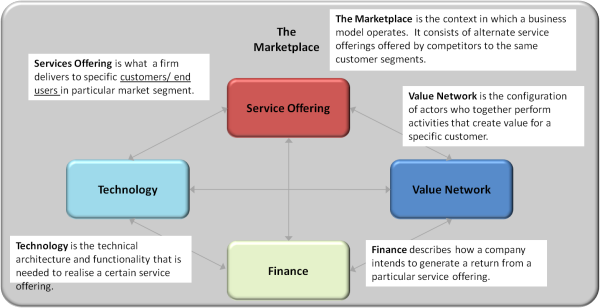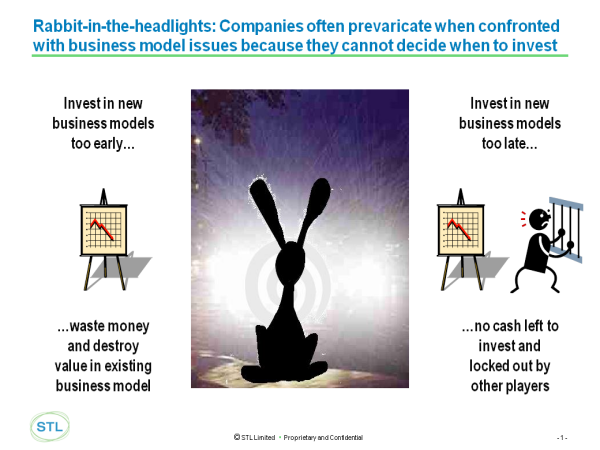Telco 2.0™ Research
The Future Of Telecoms And How To Get There
The Future Of Telecoms And How To Get There
|
Summary: What is a ‘business model problem’? How can you tell when you’ve got one? What are the key business model challenges faced by telcos today, and how should they address them? (February 2012, Foundation 2.0) |
|
To share this article easily, please click:
This short introductory paper provides a brief overview of:
NB. STL Partners focuses on ‘business model innovation’ in the digital economy, outlining the theory, opportunities and best practice in the field, and developing new strategies for clients. It also runs the Telco 2.0 and Digital Entertainment 2.0 Initiatives to research and promote new business models in those sectors.
A ‘business model’ is a structured articulation of a company’s strategic approach to making money.
Building on academic research into business model design, STL Partners has developed a five-part Business Model Framework as a core analytical tool (see Figure 1). STL Partners uses this framework to help consider all the implications of changes made to a business model. As well as considering the activity of a single organisation, it analyses how companies interact to deliver value and the specific roles played by different players.

Essentially, a service offering is delivered to customers in the marketplace (in competition with alternative products and services, and within the context of legislation and regulation). The value network is the collection of companies that together deliver the service offering – so, for example, a value network may include content partners or network infrastructure providers. They are supported in their activities by technology, which provides the specific functionality required to deliver the service offering. The whole ecosystem lives or dies according to its ability to make money (finance), which also determines the capital investment flowing into the ecosystem.
A ‘business model problem’ can present a structural challenge to the sustainability of a company’s or an industry’s core approach to making money. In many cases, threats – and opportunities - are created by new business models coming into competition with existing ones.
Business model problems typically can’t be solved simply by employing a better sales manager, a price cut, or incremental cost cutting. Lateral solutions are needed which may involve new utilisation of existing assets or capabilities. The Roadmap to New Telco 2.0 Business Models report describes the strategic business model innovation opportunities we see for telcos.
Business model problems often manifest themselves as an insidious decline in business performance even in the absence of an obvious economic, operational or directly competitive threat. Further signs of a ‘business model problem’ include:
Figure 2 below summarises why many companies get caught out even if they know they face an issue with their business models.
Fundamentally, it is very difficult to embark on change when a business has been set on one successful business model for many years, has many assets wrapped up in this endeavour, and is still making substantial revenues and profits from this business – even if the need for change is obvious.

The underlying digitalisation of products, services, information and communications is creating a commonality of skills and capabilities across many previously disparate players in the new hyper-connected digital economy. IT companies, technology vendors, telecoms companies, internet players, retailers and entertainment companies are starting to possess increasingly overlapping skills and assets and this leads them into more competition with each other.
Furthermore, new technologies e.g. smartphones, tablets, LTE / Fibre, Cloud Services, Apps, M2M are continually shaking up the digital economy and enabling radical business model innovations. Both consumer and enterprise end-users are responding by behaving in new ways that take advantage of increasingly mobile, on-demand, multi-device services.
Hence the ‘New Digital Economy’ is evolving at a pace and level of complexity that continually offers both threats and opportunities...
To access the rest of this 14 page Strategy 2.0 Report in full including...
...and the following report figures...
...members of the Telco 2.0 Executive Briefing service can download it in full PDF format here.
Additionally, to give an introduction to the principles of Telco 2.0 and digital business model innovation, we now offer for download a small selection of free Telco 2.0 Briefing reports (including this one) and a growing collection of what we think are the best 3rd party 'white papers'. To access these reports you will need to become a Foundation 2.0 member. To do this, use the promotional code FOUNDATION2 in the box provided on the sign-up page here. Your Foundation 2.0 member details will allow you to access the reports shown here only, and once registered, you will be able to download the report here.
We'll also be discussing digital business model innovation at the Silicon Valley (27-28 March) and London (12-13 June) Executive Brainstorms.
To access reports from the full Telco 2.0 Executive Briefing service, or to submit whitepapers for review for inclusion in this service, please email or call +44 (0) 207 247 5003.